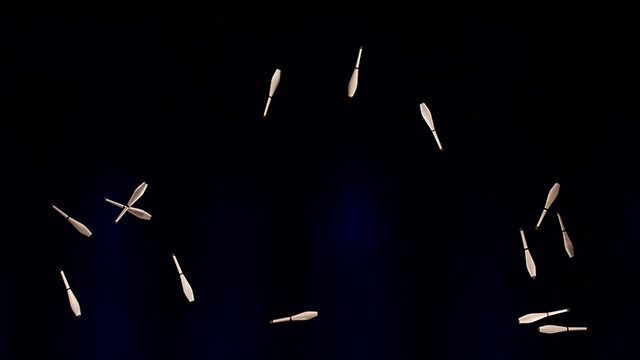This response was produced as part of the #CircusVoices scheme for developing critical languages around circus arts.

Have you ever been shot in the face with a confetti cannon while people do backflips around you??
Well this is what literally and metaphorically happens to you when you go to see Water on Mars, playing at the Assembly Roxy this August.
A juggling explosion by the aptly named “Plastic Boom” (don’t worry if you don’t recognise the name, its new) is the work of the three juggling DOCH demi-gods Patrik Elmnert, Wes Peden and Tony Pezzo, being produced under the banner of Gandini Juggling. With backing from a steady name like that you can count on the skills being off the chain. However if the Gandini’s are a Waltz in Berlin, these three are a mosh pit in a ball-pool.
Its a full on throwgasm from the second they step on stage, and the energy stays sky high throughout. The brain is bombarded with colours and patterns constantly, peaking with the soundtrack and giving you several points to watch on stage simultaneously. Its like attending a kids birthday party, but where you’re not allowed to join in the games.
The whole thing can be divided into its sections of different prop use. These guys have all bases covered; clubs, balls and rings as standard, but then also getting homemade on yo asses with sellotaped contraptions, shoes, and toilet-roll. They juggle anything. But not just for the sake of proving they can. Each object flaunts a pattern that’s integral to juggling itself. The traces of water in the air as bottles spin, the trails of toilet-paper over the heads of the audience….create a new way of viewing the art form.

Some sections stand out amongst the rest, the opening club section, where precise passes and swaps mix coloured clubs, then as if by magic re-separate them again. Likewise the white ball section shows off their ‘six hands working as one’ skills. It is truly a show built on teamwork and the pleasant surprise here is they seem genuinely happy about that. Unlike many acrobatic styled shows that relish in competition between performers abilities, here the three give off a happiness and willingness for their craft. Its infectious, and makes you believe they’d do the whole show whether people were watching or not.
You will watch though. I dare you to look away during the show. Double dare you. You won’t, because blink and the room’s changed. They leap across the stage, they transform it from day to night, from full of bouncing rings to quiet head balances. The music, lighting, complimented by the costumes and set make it feel like you’re stepping into a full world. Where true beauty is juggling, and the beholder’s eyes are the three men on stage.
The neon dream team do well to keep the audience guessing, building up concepts of juggling then immediately dashing them. Deliberate drops, magnetic clubs and the idea that not everything thrown is supposed to be caught. Providing innovation and gently humorous moments.

This is where perhaps we see the cracks of this show, performed for three years but constantly changing and evolving, we witness fleeting sections that seem to try too hard to get a laugh or to be deliberately strange. But, with time, I imagine the integration of magic cards and piñatas will blend far more seamlessly into the juggling, and blame the fact they are recent additions for the feeling of unsettlement.
To me they seem like an attempt to connect to an audience, to pause and reveal the self, which is unnecessary. Because the men actually do that through their juggling. The small moments of moving balls pointlessly across the stage, the wrapping in sellotape, timed jumps, points and nods. Here we see the performers, and we connect to them in these movements.
The true high point of the show is the duet between Wes and Tony or, more accurately, between a plastic box and a red ball. The piece is not only full of great tricks, but they build in the same organic way that juggling itself does. To watch it is to be tricked into thinking they are discovering and creating the sequence right then and there. Allowing the props to lead the ideas for the next trick. The movement is a delight to watch, giving what feels like a glimpse into the juggling performers world, how they play, create, compose.
They make this section, and by extension the whole show, not about them as individuals or performers or humans, but about juggling and their bodies merely the machine that creates it.
Which is confusing when it comes to their marketing here in Edinburgh, going under a blurb and copy of “as good as sex and better than chocolate” because, despite there being the odd chocolate in the show, there’s zero sexiness. Which is fine, and is not hindering their success at all.
Maybe gone are the days when we need to sell a circus show based on sex and glam and spectacle. Maybe now we’re ready, as an audience, to see shows built on passion and love for the craft, not love of the applause. Maybe here and now we see the gears begin to turn for the changing face of circus. Maybe, we’ll see more shows created to expand a skill and inspire an audience.
But maybe that’s all too long for the Edinburgh Fringe guide.

.




